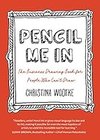
Saved by Scott Sigal and
Pencil Me In

Saved by Scott Sigal and
When problems are really tough, we need to get drawing. We draw to see what we think, in order to evaluate those ideas. When ideas are made physical, they are tangible enough to understand and communicate. Scientists call
this “distributed cognition.” Business people call it “design thinking.” Whatever you call it, it works!
When problems are really tough, we need to get drawing. We draw to see what we think, in order to evaluate those ideas.
Life Drawing The art of looking at the world and shutting up your verbal brain so you can draw what you see. The best book for this is Betty Edward’s Drawing on the Right Side of the Brain.
Kate Rutter will explain how. Learn more about Kate at http://intelleto.com
Pick a font you like, and copy it by hand.
Idea Sketching (Also Called Doodling) All about getting the stuff in your head out on the paper where you can see, evaluate, and share it.
Panel One: Show your key customer, their goal and motivation. What do they want? Why? Here we see a mom: “I want to lose weight to be healthy, so I can dance at my daughter’s wedding someday.” Panel Two: The inciting incident. What makes the customer decide to journey toward her goal. “Oh my! I weigh what?!?” Panel Three: How she currently tries to
... See moreWhen I was at Kansas City Art Institute, drawing was taught as a kind of Zen practice. You were taught that your idea of a face or a house got in the way of truly seeing it. You needed to stop thinking about what it was and relax into seeing what really was there.